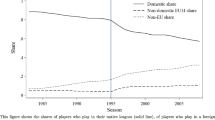Abstract
Major League Baseball’s system of sharing revenue between clubs was altered significantly in 1997. The arrangement progressively redistributes income from the highest toward the lowest revenue-generating clubs. The purpose of the new method was to alleviate growing disparity in revenue generation. However, under the progressive system the lowest revenue producing clubs bear the highest marginal tax rates, and theoretically problems of competitive imbalance may be amplified. Changes in talent distribution are observed by analyzing player mobility; an empirical model of player transfers is developed and tested. Confirmation is obtained that low revenue clubs acted on increased incentives to divest talent.
Similar content being viewed by others
References
Associated Press. (2004). Revenue sharing disparities keep growing: Top MLB clubs continue to pay more to small-market squads. [Electronic version] Retrieved September 28, 2009 from http://nbcsports.msnbc.com/id/4999856/.
Atkinson S., Stanley L., Tschirhart J. (1988) Revenue sharing as an incentive in an agency problem: An example from the national football league. Rand Journal of Economics 9(1): 27–43
Daly G., Moore W. (1981) Externalities, property rights, and the allocation of resources in major league baseball. Economic Inquiry 19(1): 77–95
Farber, H. S. (1999). Mobility and stability: The dynamics of job change in labor markets. In: Handbook of labor economics, 3(B). (pp. 2439–2483). Amsterdam, The Netherlands: Elsevier.
Fort, R. (2007). Sports business data pages. Retrieved September 28, 2009 from http://www.rodneyfort.com/SportsData/BizFrame.htm
Fort R., Quirk J. (1995) Cross-subsidization, incentives, and outcomes in professional team sports. Journal of Economic Literature 33(3): 1265–1299
Jovanovic B. (1979) Job matching and the theory of turnover. Journal of Political Economy 87(5): 972–990
Kesenné S. (2000) Revenue sharing and competitive balance in team sports. Journal of Sports Economics 1(1): 56–65
Lahman, S. (n.d.). Sean Lahman’s baseball archive: Statistics. Retrieved September 28, 2009 from http://baseball1.com/content/category/6/35/65/
Maxcy J. G. (2002) Rethinking restrictions on player mobility in major league baseball. Contemporary Economic Policy 20(2): 145–159
Quirk J., El Houdari M. (1971) An economic model of a professional sports league. Journal of Political Economy 79(6): 1302–1319
Rascher D. (1997) A model of a professional sports league. In: Hendricks W. (eds) Advances in the economics of sport. JAI Press, Greenwich, CT, pp 27–76
Retrosheet.org. (n.d.). Directory of players. Retrieved September 28, 2009 from http://www.retrosheet.org/boxesetc/index.html #Players.
Rottenberg S. (1956) The baseball players labor market. Journal of Political Economy 64: 242–258
Syzmanski S. (2003) The economic design of sporting contests. Journal of Economic Literature 41: 1137–1187
Syzmanski S., Kesenné S. (2004) Competitive balance and gate revenue sharing in team sports. The Journal of Industrial Economics 52(1): 165–177
Vrooman J. (1996) The baseball players’ labor market reconsidered. Southern Economic Journal 63(2): 339–360
Zimbalist A. (2003) Labor relations in major league baseball. Journal of Sports Economics 4(4): 332–355
Zimbalist, A. (2006). New MLB labor deal corrects earlier flaws, lays foundation for growth. Street & Smith’s Sports Business Journal 9 (27, November 6), 27.
Author information
Authors and Affiliations
Corresponding author
Rights and permissions
About this article
Cite this article
Maxcy, J.G. Progressive Revenue Sharing in Major League Baseball: The Effect on Player Transfers and Talent Distribution. Rev Ind Organ 35, 275–297 (2009). https://doi.org/10.1007/s11151-009-9229-9
Published:
Issue Date:
DOI: https://doi.org/10.1007/s11151-009-9229-9




